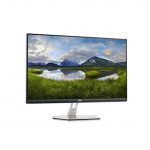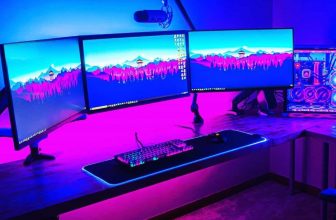New 4k monitors have made gaming more enjoyable in recent years. Both PC and console gamers have adopted this format. There are upgraded consoles that can take advantage of the new screens’ greater detail. There are some tradeoffs to this format. 4k screens tend to have slower refresh rates and therefore slower response times than lower-resolution & faster refresh rate counterparts. Some 4k 144Hz monitors now include HDMI 2.1 support. This allows you to achieve a higher frame rate for a better gaming experience.
After testing over 350 monitors, here are our top picks for a 4k 144Hz monitor. We have wrapped up our recommendations below with some additional info intact. Let us now go through the review.
Best 4k 144Hz Monitors: Top 5 To Buy Now in 2023-24
| S No | 4K 144hz Monitors | Reviews |
| 1. | Dell S2721QS | 5/5 |
| 2. | Asus ROG Strix XG27UQ | 4/5 |
| 3. | Gigabyte AORUS FV43U | 4/5 |
| 4. | Acer Predator XB273K | 4/5 |
| 5. | Acer ConceptD CP7271K | 4/5 |
1. Dell S2721QS
Dell S2721QS
2. Product Dimension 61.16 x 17.48 x 51 cm
3. 1/4-inch Audio, DisplayPort & HDMI
The Dell S2721QS 4k monitor is affordable and suitable for many uses. The large screen allows for multitasking and the high pixel density ensures sharp text and images. You can move the stand to make adjustments easily. The IPS panel is wide enough that you can share your screen with others.
It offers a quick response time and low input lag. Additionally, it supports variable refresh rate technology (VRR) to reduce screen tearing during gaming. Although the refresh rate is limited at 60hz, it should not be a problem for most gamers as 4k gaming is still very demanding. The contrast ratio of IPS panel monitors is low, making blacks look grayish in dark. It is not bright enough to combat glare but it doesn’t provide a satisfying HDR experience.
2. Asus ROG Strix XG27UQ
Asus ROG Strix XG27UQ
2. Product Dimension 24.9 x 21.9 x 10.6
3. HDMI (v2.0) x2, DisplayPort 1.4 x2 ports
The Asus ROG Strix XG27UQ 4K is one of the best gaming monitors. The XG27UQ does not have a premium FALD-backlight for HDR, but the screen’s edge-array backlight is effective and Dynamic Dimming features are impressive.
Input lag and response time, the ROG Strix XG27UQ performs well in all tests. The ROG Strix XG27UQ performed better than other 144Hz monitors such as the Acer Predator X27 or Asus ROG Swift PG27UQ which cost way more. Even though the XG27UQ monitor is not listed as a FreeSync model, it can run G-Sync.
3. Gigabyte AORUS FV43U
Gigabyte AORUS FV43U
2. Product Dimension 38.08 x 25.12 x 9.89
3. USB Type C, DisplayPort, HDMI & USB 3.0
The Gigabyte AORUS FV43U 43-inch monitor has a 4k VA panel, a fast 144Hz refresh speed and a 43-inch screen. This monitor is primarily intended for console gaming and looks more like a TV rather than a conventional monitor. X gamers and a remarkable response time at the max refresh rate for PC gamers. It is extremely contrasty, which results in deep blacks even in dark rooms, and it has great black uniformity.
It has an objectively low input delay, but it is still a little higher than other comparable monitors. The 60Hz response time might be a disappointment to console gamers. The included stand is fixed and does not have any ergonomic adjustments. Some users may want to use a mounting arm rather than the stand.
4. Acer Predator XB273K
Acer Predator XB273K
2. Product Dimension 30.7 x 62.9 x 44.1 cm
3. 2 x Display Port, 2 x HDMI, 4 x USB 3. 0 Port
The Acer Predator XB273K 4K gaming monitor is a little cheaper than the other 144Hz options. It has the ideal refresh rate for value-seekers and is a great choice. There was no blur in fast-paced games when the settings were maxed. G-Sync was able to work with both HDR and standard content to combat screen tearing when used in conjunction with an Nvidia graphics card. The monitor performed well against other 144 Hz monitors during testing. It even beat the Acer Predator X27 and Asus ROG Swift PG27UQ, both of which cost a bit more, when it came down to input lag.
The Predator XB273K’s image quality is excellent. It achieves a pro-level level of color accuracy and contrast. We tested it and we were able to see a difference of over 4,000:1 and 2,000:1 following our calibration. HDR looks less sharp than HDR on monitors with FALD-backlights but the Predator XB273K is our favorite.
We Believe you are a Gaming Enthusiast, You Might like best 240Hz Monitors
5. Acer ConceptD CP7271K
Acer ConceptD CP7271K
2. Product Dimension 62.99 x 26.92 x 59.94 cm
3. USB, DisplayPort, HDMI and USB 3.0
The lines that separate professional gamers from gamers are blurring. A photo editor might want to play during their spare time. Because of its impressive gaming specs, and precise color space coverage, the Acer ConceptD CP271K 4K gaming monitor is the best for professionals.
The monitor’s 110% coverage in the DCI-P3 color space is ideal for creative professionals. However, the more meticulous may find it a little too bright. However, you can reduce the color using a software lookup table. A FALD backlight, which can reach 1,000 nits, also produces excellent HDR output.
The conceptD CP271K also offers gamers precise sRGB coverage (96.3%) as well as powerful performance that matches 144 Hz gaming monitors in response times and input lag benchmarking.
Choosing 4K 144Hz Monitor: Things to Keep in Mind
For the best 4K 144Hz monitor, consider these factors:
- 4K & HDR
For brighter and more colorful images, 4K displays often support HDR content. For Adaptive-Sync optimized HDR media, you will need a G-Sync Ultimate Pro or FreeSync Premium Pro. Opt for 600 nits brightness to make a significant upgrade from an SDR monitor.
- High-End Graphics Card
You will need a minimum of a GTX 1070 Ti or RX Vega 64 if you aren’t using an Nvidia SLI multi-graphics card setup or AMD Crossfire multi—graphics card setup. For games with medium settings, an RTX-series or Radeon VII card is required.
- FreeSync or G-Sync
G-Sync on a monitor will not work with computers with Nvidia graphics or AMD cards. FreeSync is only compatible with AMD cards. Although you can technically use G-Sync with a monitor that is only FreeSync-certified, the performance might be different. There are no differences between mainstream gaming capabilities and screen tearing.
These recommendations are based upon what we consider to be the best 4k 144 Hz, gaming monitors. All these suggestions have been adjusted to make them applicable for all price brackets. Our review takes into account the price and the feedback of our users.
Here are all our 4k monitor reviews. Don’t get caught up in the details. Most monitors will satisfy most people. The things that monitors can’t do well with are not often noticeable unless they are really there. Good Luck with your choice!!
Frequently Asked Questions (FAQs)
Q1. Is a 4K Gaming Monitor Worth it for PC Gaming?
The most important thing to think about is whether you own the right hardware to make the most of your 4K monitor.
Upgrading to the top graphics cards will make sure that your computer plays a game slideshow at 4K. It is helpful if you aim to get a big screen too.
Q2. How do We Test 4K Gaming Monitors?
There are two methods to test a screen to determine if it’s the most suitable gaming monitor.
- One is by playing games on the screen. Testing the gaming performance on every screen allows you to test the performance of aspect ratios, the native resolution as well as any particular gaming-specific technology they’re sporting.
- Comparison testing. It is done for identifying the often subtle differences between the two panels. When you’re using a screen in isolation, it is easy to become blind to its flaws because you’ve become accustomed to these screens. By testing screens back-to-back, we can identify and highlight particular differences between the two screens.
Q3. Should I go for an IPS, TN, or VA Panel?
We recommend using an IPS panel instead of TN. The clarity of image view angle, viewing angle, and color rendition are superior to cheaper technologies. However, you can often get a better TN for a reasonable price.
Another option, which is cheaper than IPS and superior to TN is VA technology. The colors aren’t so amazing however, the contrast performance is impressive.
Q4. Should I go for a G-Sync or FreeSync Monitor?
It is generally accepted that FreeSync displays are generally less expensive. They were only compatible with AMD GPUs. This was the case with G-Sync monitors as well as Nvidia GPUs. Today, however, you can find G-Sync capable FreeSync monitors if you’re on a tight budget.
Q5. What Aspect Ratio should I Go For?
The latest movies and games are best played in widescreen formats in a 16:9 aspect or higher. When you use 4:3, films will appear stunted by black stripes along the bottom and top. There are many small variations to every ratio but at the end of the day, the choice is based on your own personal preferences.
Another option, if you have some extra money, is ultra-wide such as 32:9, 21:9, and their variations. They will give you a more immersive and encompassing experience. In fact, you can also completely surround yourself with a curved screen, it’s whatever you want.
A wide range of games is compatible with these ultrawide resolutions. Although they aren’t always full-HD. But they will need the same amount of power from your GPU, and provide the same high-quality and engaging experience.















